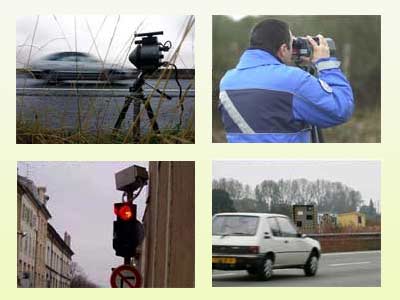For many years, the number of fatalities due to traffic accidents in France consistently hovered around 8,000 per year, a rate that is high compared to other countries in the region. However, in 2005, the number of traffic-related deaths in France decreased to approximately 5,000. This decline can be attributed to various factors, including the installation of speed measurement radar systems aimed at preventing traffic violations.
With 28.7 million personal vehicles, 5.6 million commercial and passenger vehicles, France has become one of the countries with the highest number of cars in Europe. In 2005, the French government installed 1,000 automatic speed measurement radars, categorized into five types:
First, fixed automatic cabins were installed along national highways at the borders of small towns or at intersections between urban and suburban areas, resembling utility poles. Currently, 692 of these are distributed across 98 provinces in France. It is estimated that 500 radars generated approximately 170 million euros for the state budget, meaning that with 1,000 radars, the French budget collected around 340 million euros in fines in 2005.
Second, these radars are often discreetly placed in unexpected locations such as under bridges, behind bushes, or at pedestrian crossing bypasses, equipped with high-precision binoculars. These radars have become a nightmare for speeding drivers, with 213 currently operational across 92 provinces.
Third, laser cameras, referred to as the “persistent torment” for motorists. However, not every action by the users is enforced; if a user deliberately adjusts the data incorrectly, the machine will automatically “sleep.”

Speed radars installed in various locations. (Photo: CAND)
Fourth, automatic radars positioned at traffic intersections, specifically above traffic lights, operate like cameras. When they detect a vehicle exceeding the speed limit or running a red light, they immediately record the license plate number, time, and location of the violation, then automatically transmit this information to the monitoring and violation processing center. The center’s computer searches for the vehicle owner’s personal data through the license plate and automatically prints a fine notice. The notice specifies the owner’s name, address, and details of the violation. The role of the traffic police is simply to send this notice to the vehicle owner along with a report.
Within a week, the fine amount is halved if the vehicle owner pays promptly; otherwise, the fine increases exponentially. In cases where someone else borrows the vehicle, the vehicle owner must provide the personal details of the borrower. However, the owner must first pay the fine; only when the provided information is deemed accurate will the fine be refunded. This system serves as a crucial tool for the enforcement of traffic laws by the French traffic police. Currently, this type of radar is installed in five cities in France: Le Vésinet (78 locations), Toulouse (31 locations), Metz (57 locations), Paris (75 locations), and Nancy (54 locations).
Fifth, specialized radars for motorcycles and police vehicles. These radars are commonly used during police patrols and are discreetly placed under the flashing lights of motorcycles, connected to audio recording devices. This type has proven effective on France’s E40 and E411 highways.
However, the implementation of this radar system, which began in late 2003, did not initially receive public consensus in France. On the contrary, many voices opposed it, arguing that the government was deliberately pressuring drivers, especially long-distance drivers. Thus, it took a long time to conduct extensive outreach about the benefits of the radar system to the public, including the immediate establishment of locations for each radar station on a nationwide map, along with warning signs on highways. Simultaneously, the French government allowed transparency regarding the purpose of the fines collected. Accordingly, 60% of the total fines are reinvested in the maintenance and upgrading of such equipment, while the remaining 40% is allocated to the Ministry of Investment for infrastructure development and road safety improvement.
As a result, after the automatic speed measurement radar network became operational, an average of 150,000 to 200,000 fine notices were issued monthly. Thus, each radar generated about 20 fines per month. Seventy percent of violating vehicle owners complied with timely payment, with only 2% contesting the fines. According to statistics from the French Speed Measurement Oversight Agency, the average driving speed has decreased by 5 km/h. Ultimately, it is only the automatic speed measurement radars that have changed the high-speed driving habits of the French—something tens of thousands of police officers previously struggled to address.
In 2005, the French government spent 400 million euros to purchase 1,000 speed measurement radars, but the economic impact has been substantial: annual economic losses dropped from 30 billion euros to 24 billion euros; additionally, 200 million euros were collected in traffic violation fines. In 2006, the French government continued to install an additional 500 radars of this type and conducted final tests of the global positioning system to limit speed for broader implementation.
Hoàng Hạnh




















































